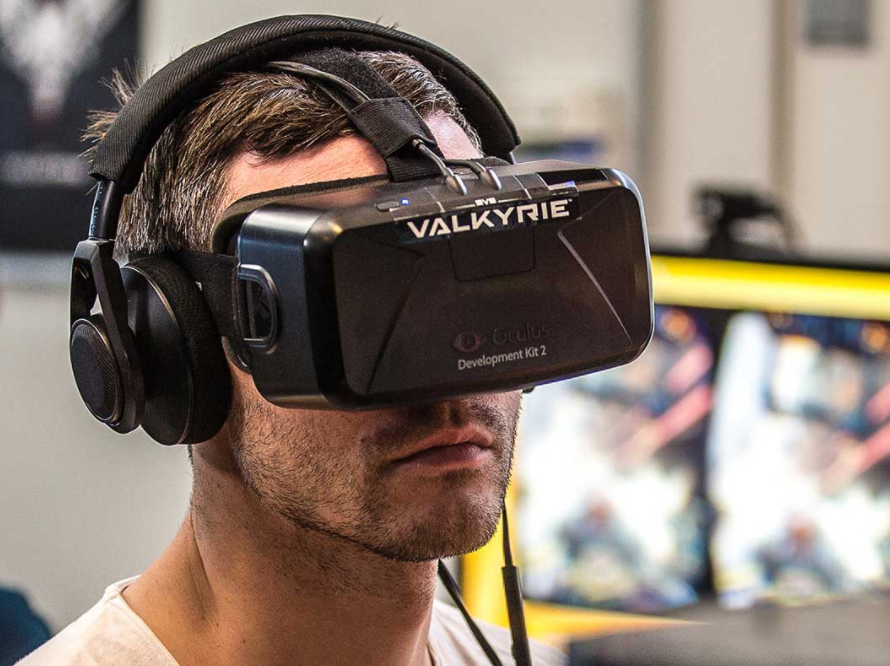March 28 marks the official one-year anniversary of the Oculus Rift launch—the first premium VR headset for the consumer market. Its major competitor, the HTC Vive, hit the market a week later on April 5 while console players had to wait until October 13 before they could step into virtual worlds with PlayStation VR headsets.
One of the things all three headsets have in common is the game EVE: Valkyrie, a space flight dogfighting simulator that blew audiences away with its fast-paced gameplay. In it, pilots could engage in combat amid gigantic capital ships, making Valkyrie a clear and early demonstration of the potential VR has as an entertainment medium. As such, it was bundled together for free with pre-order sales of the Rift and has been a featured launch game for all the premium headsets.
EVE Online developer, CCP has been a longtime and enthusiastic supporter of virtual reality. It began development on Valkyrie before Oculus VR was purchased by Facebook. The developer also created the arcade shooter, Gunjack—also based in the EVE universe—and its sequel for the Samsung Gear VR mobile device before bringing them to premium headsets and Google Daydream. This year, the company’s Atlanta studio is out to create an all-new sport using virtual reality with Sparc, and it seems clear that CCP is just getting started.
CCP CEO, Hilmar Veigar Pétursson and Ryan Geddes, the company’s senior brand director, sit down to talk with [a]listdaily about how Valkyrie has grown and how the company is gearing up to further pioneer the VR space as it enters its second year.

How has EVE: Valkyrie grown since its launch last year?
[Geddes]: It’s been a crazy ride. When we launched in March 2016, there was no such thing as a VR market. We were literally making up the rules as we went along. We probably still are. Since we launched alongside the Oculus Rift as a pre-order bundle on March 28, we’ve expanded onto two more platforms—PlayStation VR and HTC Vive/Steam—and grew a dedicated community of VR enthusiasts. To me, they are the real story. There is a passionate, excited and discerning group of people out there pushing gaming into a whole new world. CCP wouldn’t be succeeding in VR without them, and we have a responsibility to keep blowing their minds. Not literally. We don’t have that technology. Yet.
What is the key to keeping players engaged with EVE: Valkyrie for over a year?
[Geddes]: As much as possible, we try to keep our pilots at the center of the conversation. We are a competitive multiplayer game, and that comes with a certain set of expectations and challenges. What do our pilots want and need from this experience? Where are the moments of joy or frustration? It’s always a balance, but we try to address those things as much as possible and move the experience forward for them. To date, we’ve released four major updates to the game, bringing in new maps, new modes and new features. Our last update, Wormholes, was specifically designed to give our community a whole new way to fly. It’s firmly rooted in the core competitive dogfighting our pilots love, but it twists the gameplay in strange and unpredictable ways. With Wormholes, we’re never completely sure how things will unfold—and that’s where weird, cool things start to happen.
EVE: Valkyrie has an average session length of 60 minutes (which is very favorable in comparison to multiplayer games like Battlefield at 90 minutes) and a solid core community of players. Some of those people are playing for an average of eight hours per day for weeks on end. We think EVE: Valkyrie demonstrates that VR multiplayer games can have the same lasting appeal as other multiplayer games, provided you back up your initial offering with substantial post-launch support.
How were you able to connect all three premium VR platforms into one multiplayer experience?
[Geddes]: Cross-platform VR play was our goal from the very beginning of development. We believed in the medium, and we knew it would never be confined to a single platform. That’s why we were the first in the world to pioneer cross-platform multiplayer in VR for EVE: Valkyrie, which was released as part of our Joint Strike update on October 7, 2016. Now, all EVE: Valkyrie pilots fly together and die together regardless of whether they’re using a PlayStation VR, Oculus Rift or HTC Vive. Simply saying ‘this is what VR platform X gives us, how can we make a game out of it?’ wasn’t good enough for us. Our attitude was, ‘we need to make this happen. How can we get that out of the platform?’ It has been great for our community, and we think it was the right decision.
With the launch of Oculus Touch, do you think that EVE: Valkyrie could someday be updated to somehow support motion controls?
[Geddes]: At CCP, we are huge believers in motion controls, full-body VR, and room-scale experiences. We have tackled those technologies head-on with our newest VR product, Sparc. That project grew out of an intentional R&D effort to dive into the deep end of the VR pool while first-wave products like EVE: Valkyrie and Gunjack came to market.
With EVE: Valkyrie specifically, the question around motion controls has always been, ‘Would this make our game better?’ Valkyrie is about stepping into the cockpit of a heavily armed ship and basically living out Top Gun in space, minus the beach volleyball scene (for now). It was designed as a seated experience that gets you as close as possible to that knife-edge adrenaline rush of dogfighting. We’ve experimented a lot with adding motion controls to that mix, but so far, we haven’t had that moment where everyone takes the headset off, puts the motion controllers down, looks at one another and says, “That was f***ing cool.” If we don’t have that moment, then our pilots probably won’t either. So, it’s still something we think about, but nothing we have planned right now.
What are some of the things CCP has learned about bringing games to the VR market and promoting them?
 [Geddes]: We knew we were making a great VR game, but virtual reality is an early adopter market right now. To thrive in that world, we partnered closely with companies who believe in VR as much as we do and understand the value of bringing great games to their burgeoning communities as early and successfully as possible. We were pleasantly surprised at the volume of EVE: Valkyrie sales that we saw at retail. Partnering with Sony to publish EVE: Valkyrie on PlayStation VR on disc turned out to be one of the smartest things we did. And teaming up with Oculus to include EVE: Valkyrie in the Rift pre-order bundle helped set us up for long-term success.
[Geddes]: We knew we were making a great VR game, but virtual reality is an early adopter market right now. To thrive in that world, we partnered closely with companies who believe in VR as much as we do and understand the value of bringing great games to their burgeoning communities as early and successfully as possible. We were pleasantly surprised at the volume of EVE: Valkyrie sales that we saw at retail. Partnering with Sony to publish EVE: Valkyrie on PlayStation VR on disc turned out to be one of the smartest things we did. And teaming up with Oculus to include EVE: Valkyrie in the Rift pre-order bundle helped set us up for long-term success.
No game has done more to help define what AAA means in VR for both PC and console than EVE: Valkyrie. That’s not a boast on our part—more to say that we’ve allowed ourselves the development time needed for a AAA experience. We solved the issue of simulation sickness early enough to push the boundaries of our gameplay, putting it through multiple iterations while incorporating player feedback from public playtests. We also hit a level of graphical fidelity that set us apart from other VR launch titles. So, when it came to marketing and promoting the game, we focused not so much on trying to sell the VR technology itself—we left that to the platforms. Instead, we told our story of quality, authenticity, and immersion directly to the VR consumer. That might not be the right approach for every VR title, but it was part of our strategy from the very beginning.
Do you think technological upgrades, such as new video cards and more powerful consoles (PS4 Pro and Project Scorpio) help boost interest and awareness in VR?
[Geddes]: Those advancements will definitely play a role. The addition of serious VR support and strategy by console leaders like Sony and Microsoft are important signals to consumers that this ‘VR thing’ is very real and here to stay. Everyone in the VR industry is pushing hard right now to make VR hardware more accessible and affordable. So, I think really it’s about setting up a healthy ecosystem: engines, graphics, consoles, head-mounted displays (HMDs) and streaming tech. But, of course, none of that will matter unless we are unlocking amazing experiences for customers that are only possible in virtual reality. That’s our role, and it’s one we will continue to do with EVE: Valkyrie.

How do you think the first year of VR has gone?
[Pétursson]: It’s definitely been an eventful year. We released three different games (Gunjack, EVE: Valkyrie and Gunjack 2) on every major VR platform, so we were really busy. Gunjack has gone on to sell over 500,000 units so far and has gotten tremendous customer reviews. We had a great bundle deal with EVE: Valkyrie and I think that ended up being seen as a “killer-app” for high-end VR—certainly the player engagement metrics are extremely robust. Plus, we worked closely with Google on Gunjack 2 for Daydream, so I’d say we’ve exceeded our own expectations with regards to our games and their critical and commercial success. We were prepared for the hardware to take longer than many people expected to reach a viable installed base. We’re in this for the long haul, so in that respect the first year has been really successful for us.
What do you think is in store for VR in the coming year and how is CCP planning for it?
[Pétursson]: I think this will be a tough year for VR. We are coming out of the hype cycle and now people will spend some time trying to tear it down and say, “I told you so.” All the naysayers have plenty of ammunition, so they’ll get their time in the sun. But we remain bullish about the long-term prospect of VR and think this year will be about broadening the base while building out the games and software catalog. We’ve already seen Oculus lower their price, and there’s a robust lineup of games coming out this year. We’re busy prepping for the release of Sparc from our Atlanta studio (for Oculus Rift, HTC Vive, and PlayStation VR), and we continue to release new, free content for EVE: Valkyrie. We also have a few top-secret things going on as well.
What are CCP’s goals when it comes to VR technology?
[Pétursson]: We have many different goals. In the short term, it’s all about being on the cutting edge and helping to drive the VR revolution. We firmly believe that VR has a big role to play in gaming and technology in general. Long term, we are thinking big about what VR and AR mean for society and how we fit into that, but it’s hard to know exactly what that looks like this early. It would be like asking someone to predict where smartphones would have ended up back in 2007, right after the first iPhone debuted. It even might be like asking someone to predict the iPhone back when we only had car phones. Either way, we are prepared.

